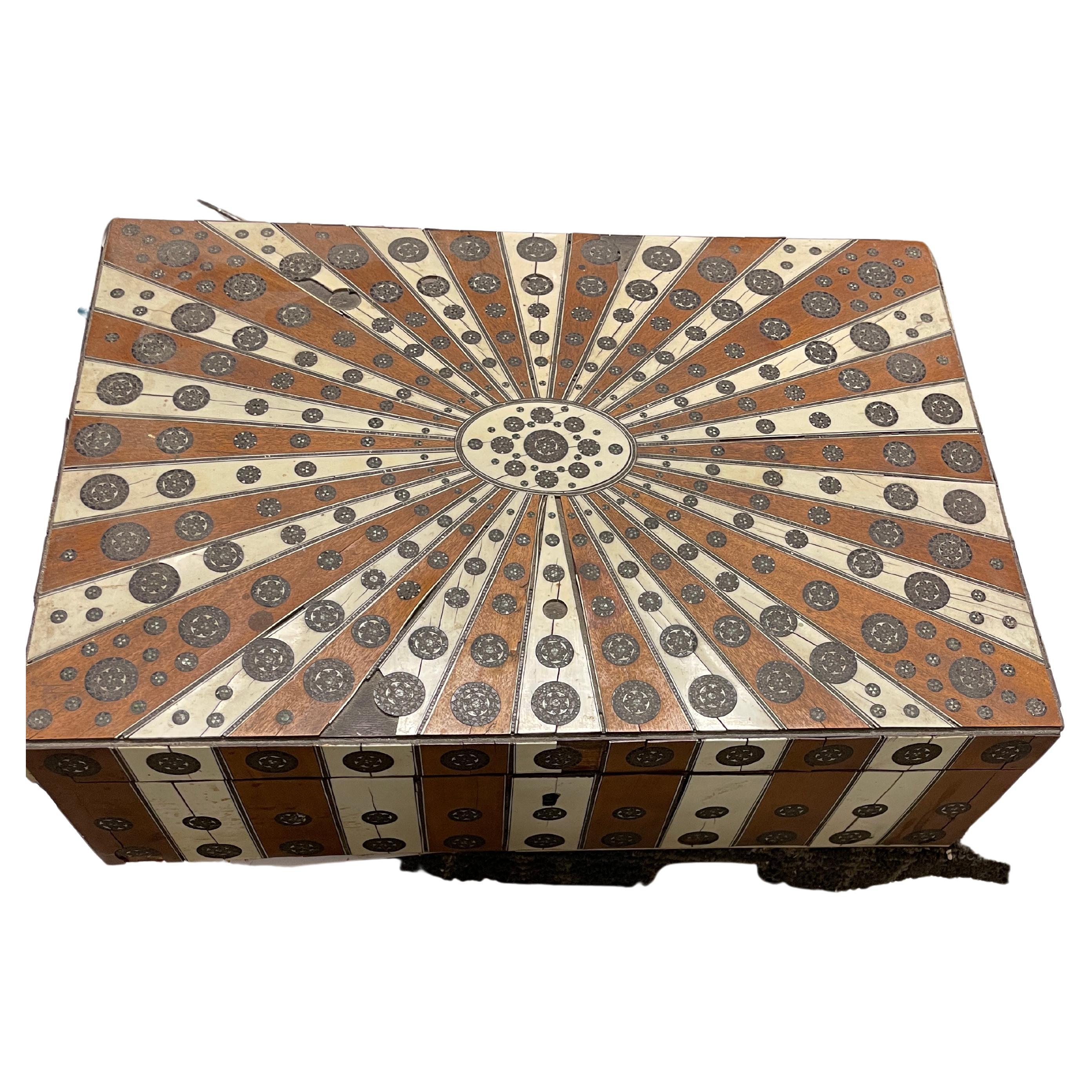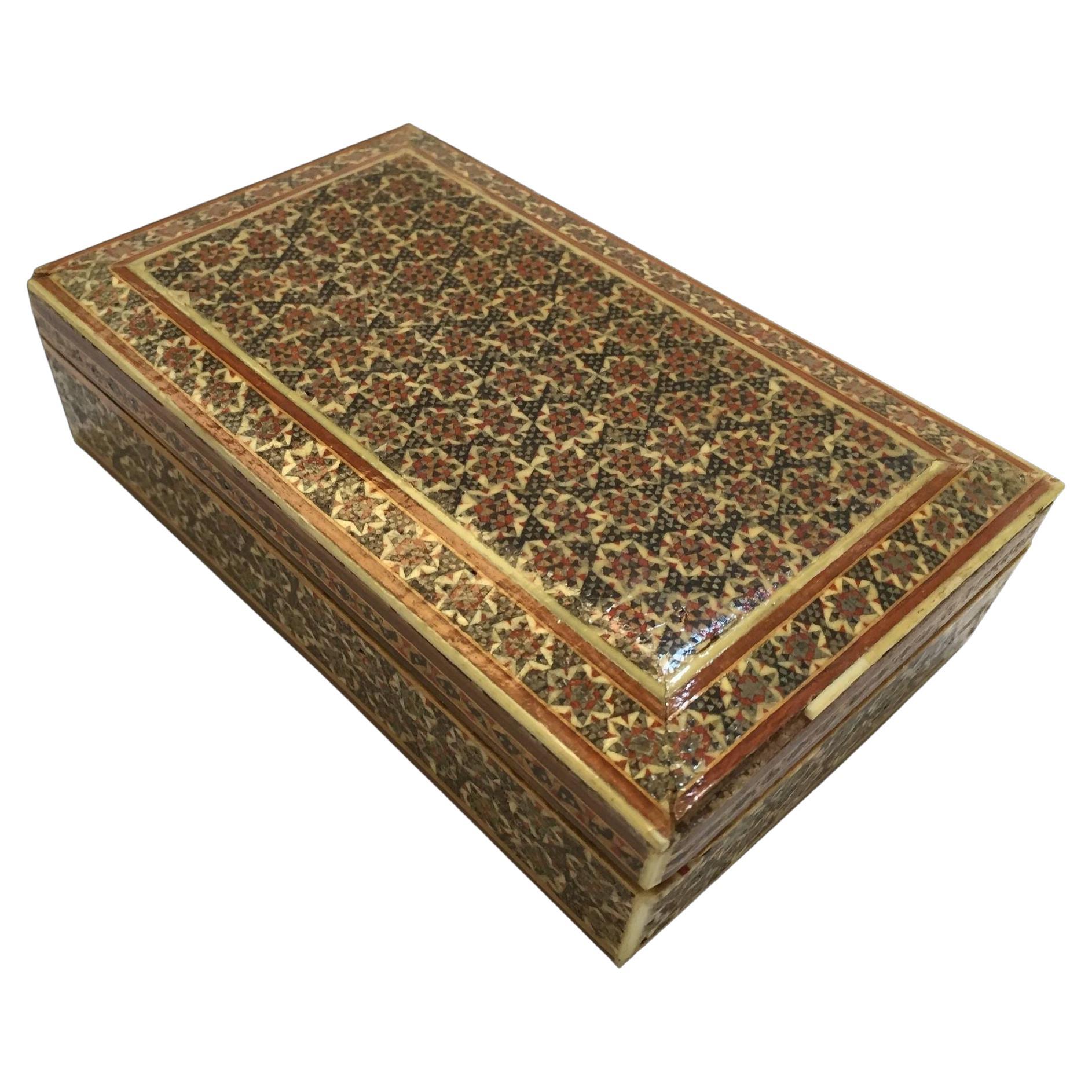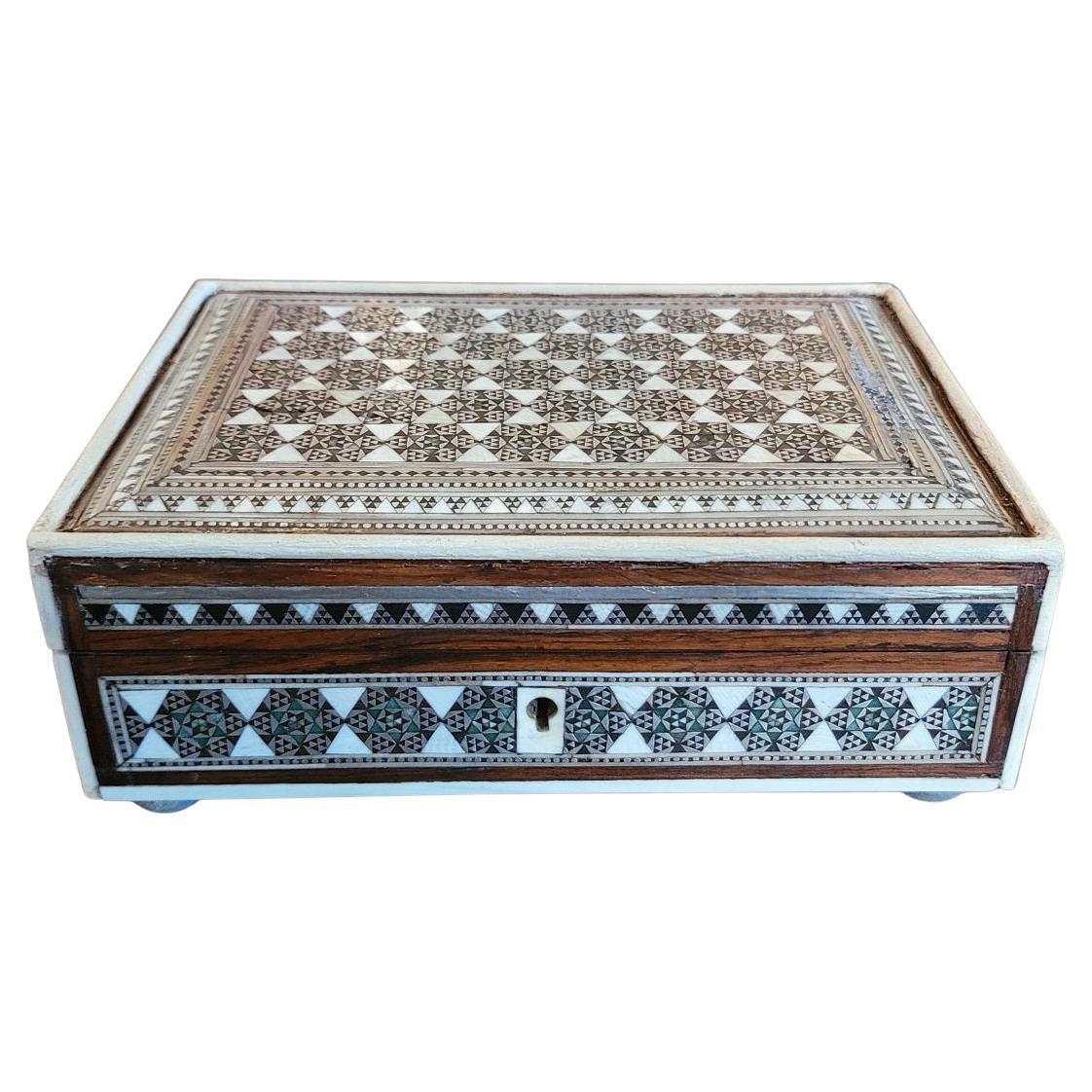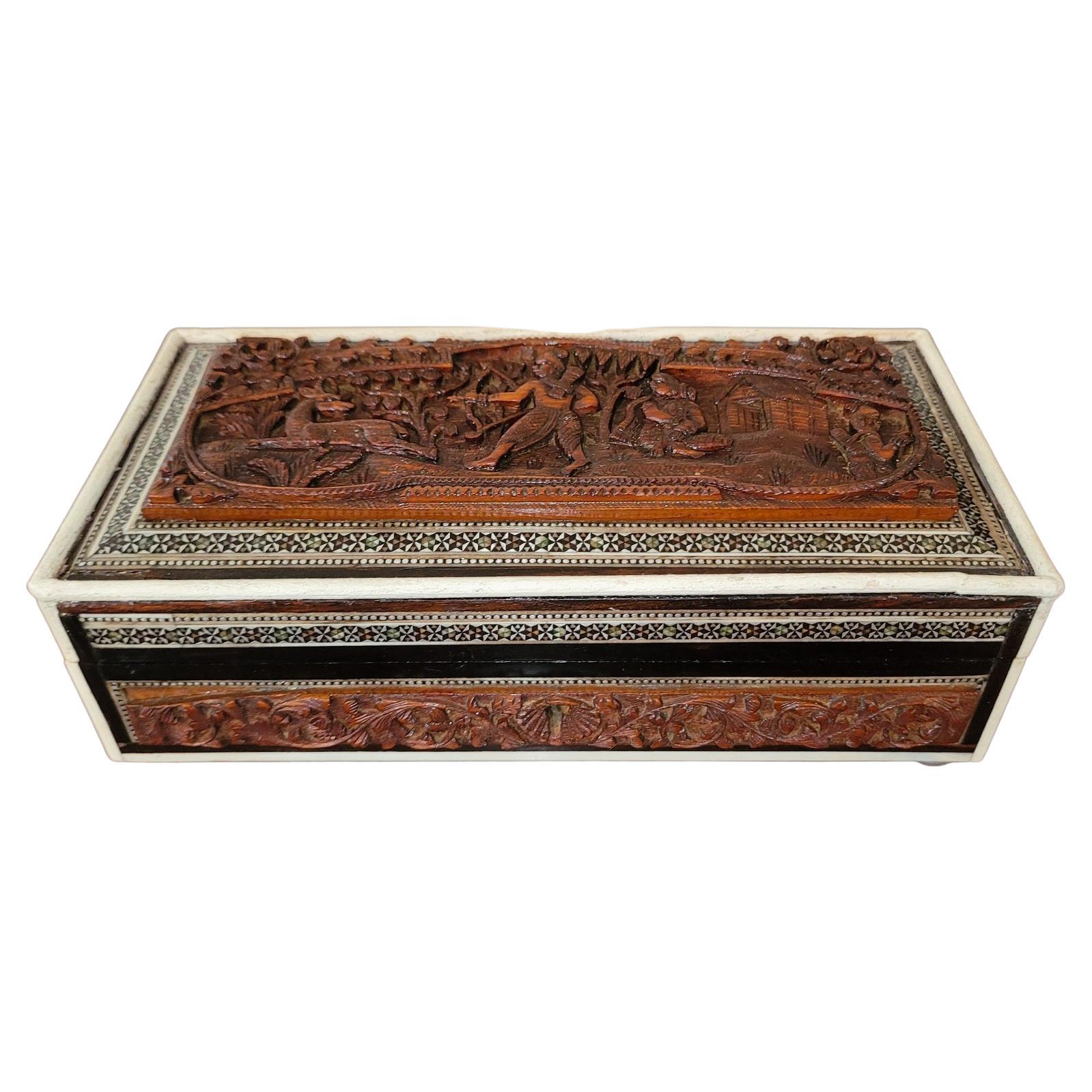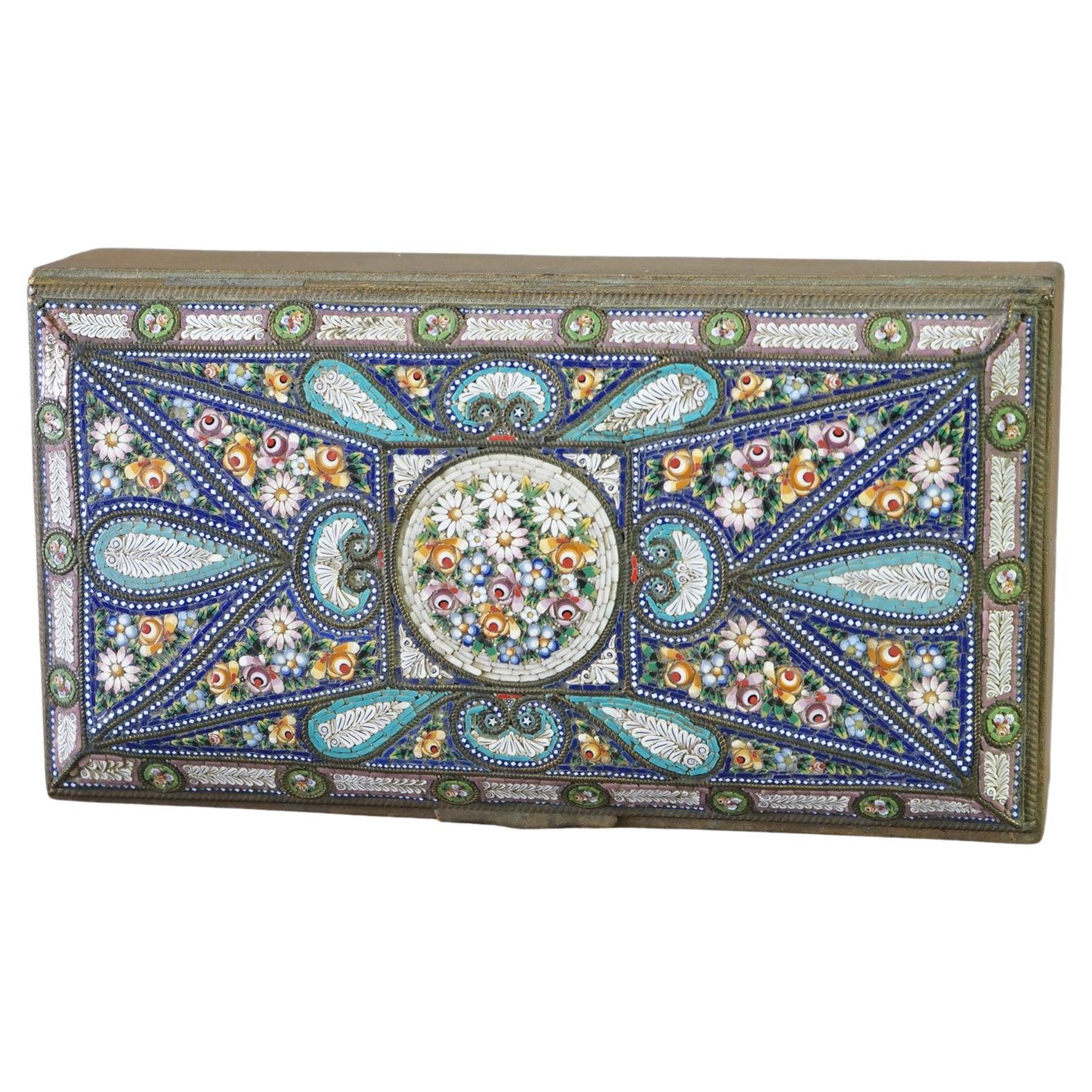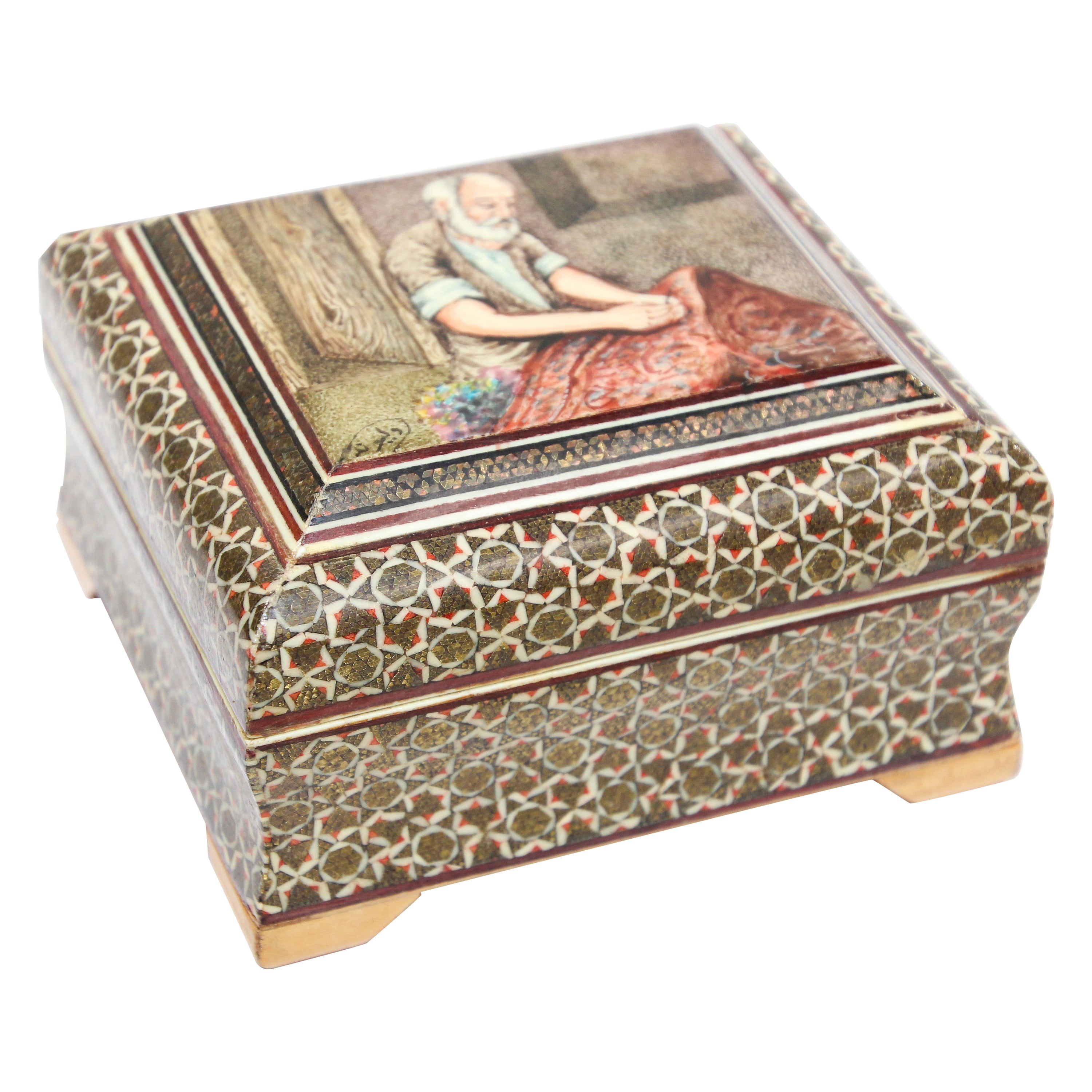Items Similar to 19C English Tunbridgeware Tabletop Stationary Box, Micro Mosaic
Want more images or videos?
Request additional images or videos from the seller
1 of 10
19C English Tunbridgeware Tabletop Stationary Box, Micro Mosaic
About the Item
Stunning little 19th century tabletop stationary box made of micro-mosaic.
Made in Britain, circa 1870, in Tunbridge Wells, hence these type of works are called Tunbridgeware!
Tunbridge ware is a form of decoratively inlaid woodwork, typically in the form of boxes, that is characteristic of Tonbridge and the spa town of Tunbridge Wells in Kent in the 18th and 19th centuries. The decoration typically consists of a mosaic of many very small pieces of different colored woods that form a pictorial vignette. Shaped rods and slivers of wood were first carefully glued together, then cut into many thin slices of identical pictorial veneer with a fine saw. Elaborately striped and feathered bandings for framing were pre-formed in a similar fashion.
The micro-mosaic is made up of thousands of tiny pieces of wood, in various colors, assembled to form an inlay and geometric pattern on the box.
This box has a micro-mosaic floral design as its central motif. It is banded on the lid and sides with more gorgeous micro-mosaic patterns.
The box itself is probably made of a combination of boxwood and raw mahogany. The wooden case is clearly irrelevant as the beauty of this piece is in its micro-mosaic overlay.
The interior is lined in its original burgundy colored red velvet and vinyl.
The interior of the lid doubles as a small writing slope.
The interior has 5 compartments, one for an inkwell (this has the original inkwell in it) and 2 with the original covers (you can really appreciate the original color on these lids. 2 open compartments.
The compartments lift off to reveal more storage underneath, for pens, etc. Again, in original condition.
This piece is in great condition having regard to its age, use and construction. It retains almost all of its original mosaic which is miraculous for these types of pieces.
- Creator:Tunbridge Ware (Maker)
- Dimensions:Height: 2.25 in (5.72 cm)Width: 10 in (25.4 cm)Depth: 6.75 in (17.15 cm)
- Style:High Victorian (Of the Period)
- Materials and Techniques:
- Place of Origin:
- Period:
- Date of Manufacture:1870
- Condition:Wear consistent with age and use. Minor fading. This piece is in great condition having regard to its age, use and construction. It retains almost all of its original mosaic, miraculous for these types of pieces.
- Seller Location:Dallas, TX
- Reference Number:1stDibs: LU3978112110481
About the Seller
4.9
Platinum Seller
These expertly vetted sellers are 1stDibs' most experienced sellers and are rated highest by our customers.
Established in 2015
1stDibs seller since 2018
349 sales on 1stDibs
Typical response time: <1 hour
- ShippingRetrieving quote...Ships From: Dallas, TX
- Return PolicyA return for this item may be initiated within 7 days of delivery.
More From This SellerView All
- 19C Anglo Indian Bombay MOP Sadeli Mosaic Trinket BoxLocated in Dallas, TXPRESENTING a LOVELY 19C Anglo Indian Bombay MOP (Mother of Pearl) Sadeli Mosaic Trinket Box from circa 1875-85. Gorgeously detailed and hand-crafted ‘sadeli mosaic’ inlay, from the Bombay Area, with deep greens with silver, pewter, mother of pearl, bone and ebony in geometric patterns. The box case, is made of sandalwood but completely covered in MOP, bone, faux ivory, ebony and mosaic inlay. Edged with faux ivory and banded with a different pattern of sadeli mosaic. Some minor damage to the top (repair is obvious in pics) and ivorine replacements to some edging, but it still a BEAUTIFUL BOX and of real QUALITY! The mosaic work is FABULOUS! Box opens to reveal its original blue velvet lining. It sits on 4 (recently added) silvered button feet. SADELI MOSAIC: “Anglo Indian boxes were made in India for the English residents from the early part of the 18th century. They were brought back or sent back to England usually by the people who had commissioned them. From the beginning of the nineteenth century they were imported more commercially, although not in any significant numbers until the middle decades. They were very highly valued, especially the early ones, to the extent that the designs were copied on late 19th and early 20th century tins. The ancient art of Sadeli Mosaic is said to have been introduced from Shiraz in Persia via Sind to Bombay, a long time before the Anglo Indian boxes were made. It was a technique, which required a high degree of skill and patience. It was executed very lavishly, in that the frequent cuts wasted a great amount of the precious materials used. The workmanship was however more than commensurable to the value of the materials. Ivory, silver, pewter (or other metals), wood and horn were cut into faceted rods which were bound together to form geometric patterns. When the glue has set, the rods were sliced in transverse sections. This gave the maker a number of angled circular pieces in the original pattern. Several variations of patterns could be achieved by combining the materials in different ways. The ivory was sometimes dyed green to give an extra color. The mosaic pieces in a combination of patterns, often separated by ivory, ebony, horn or silver stringing were used to veneer sandalwood boxes. In the early boxes, which date from the turn of the 18th to the 19th century, there are large panels of mosaic covering tops and sides of boxes. It took incredible skill to cover such large areas without any shakes or wavering of the pattern. The corners and joins on these boxes are impeccably matched. The makers (reputed to be Persian) of Sadeli mosaic made in the first two decades of the 19th century displayed a total understanding of the qualities of the different materials they used. They combined substances, which can expand and contract according to atmospheric conditions with others, which are hard and unyielding. The result was a sharp definition of the lines and patterns, which made up the whole design. On the early boxes the designs look deceptively simple. The fact is, they emerged from a culture, which had mastered geometry and understood how to generate a pattern from a set number of points. The patterns are so harmoniously combined that their incredible complexity is not immediately apparent. The earliest Sadeli boxes...Category
Antique Late 19th Century Indian Anglo-Indian Jewelry Boxes
MaterialsSilver
- 19C Anglo Indian Carved Padouk Wood and Sadeli Mosaic BoxLocated in Dallas, TXPRESENTING A LOVELY 19th century Anglo-Indian Carved Padouk Wood and Sadeli Mosaic Box, featuring a carving of a Hunt Scene. Made circa 1870 in Bombay, India during the Rule of th...Category
Antique Late 19th Century Indian Anglo-Indian Jewelry Boxes
MaterialsSilver, Pewter
- 19C Anglo Indian Sadeli Mosaic Greeting Card CaseLocated in Dallas, TXPresenting a superb 19C Anglo Indian Sadeli Mosaic greeting card case. Made in or around Bombay, India circa 1880. This is a greeting card case used for holding your greeting cards or business cards of the day ! The body of the case is made from sandalwood and it is fully overlaid with bone and highly intricate Sadeli Mosaic made up of thousands of micro mosaic pieces of bone, ebony, silver/pewter and semi precious stone. The workmanship is stupenduous !!!! This case is almost museum quality. One or two very, very minor losses of mosaic mainly where the top meets the body but otherwise near mint ! SADELI MOSAIC: “Anglo Indian boxes were made in India for the English residents from the early part of the 18th century. They were brought back or sent back to England usually by the people who had commissioned them. From the beginning of the nineteenth century they were imported more commercially, although not in any significant numbers until the middle decades. They were very highly valued, especially the early ones, to the extent that the designs were copied on late 19th and early 20th century tins. The ancient art of Sadeli Mosaic is said to have been introduced from Shiraz in Persia via Sind to Bombay, a long time before the Anglo Indian boxes were made. It was a technique, which required a high degree of skill and patience. It was executed very lavishly, in that the frequent cuts wasted a great amount of the precious materials used. The workmanship was however more than commensurable to the value of the materials. Ivory, silver, pewter (or other metals), wood and horn were cut into faceted rods which were bound together to form geometric patterns. When the glue has set, the rods were sliced in transverse sections. This gave the maker a number of angled circular pieces in the original pattern. Several variations of patterns could be achieved by combining the materials in different ways. The ivory was sometimes dyed green to give an extra color. The mosaic pieces in a combination of patterns, often separated by ivory, ebony, horn or silver stringing were used to veneer sandalwood boxes. In the early boxes, which date from the turn of the 18th to the 19th century, there are large panels of mosaic covering tops and sides of boxes. It took incredible skill to cover such large areas without any shakes or wavering of the pattern. The corners and joins on these boxes are impeccably matched. The makers (reputed to be Persian) of Sadeli mosaic made in the first two decades of the 19th century displayed a total understanding of the qualities of the different materials they used. They combined substances, which can expand and contract according to atmospheric conditions with others, which are hard and unyielding. The result was a sharp definition of the lines and patterns, which made up the whole design. On the early boxes the designs look deceptively simple. The fact is, they emerged from a culture, which had mastered geometry and understood how to generate a pattern from a set number of points. The patterns are so harmoniously combined that their incredible complexity is not immediately apparent. The earliest Sadeli boxes...Category
Antique Late 19th Century Indian Anglo Raj Decorative Boxes
MaterialsBone, Precious Stone, Ebony
- 19C Anglo Indian Highly Carved Padouk Sadeli Mosaic Scroll Box of Hindu GodsLocated in Dallas, TXPRESENTING AN ABSOLUTELY STUNNING AND EXCEPTIONAL 19C Anglo Indian Highly Carved Padouk Sadeli Mosaic Scroll Box of Hindu Gods from circa 1870-80. The box case is made from sandalwood with highly hand-carved padouk wood reliefs on all sides and banded and edged in fabulous ‘Sadeli Mosaic’, made from faux ivory/bone, ebony, silver, semi-precious green stone, etc., in various geometric patterns. The carved lid of this box is EXCEPTIONAL! It is HIGHLY HAND-CARVED and depicts 13 Hindu Gods: Vishnu, Shiva, Harihara, etc., in 9 oval shaped reliefs, surrounded by foliage etc. The sides and rear have highly carved foliage relief panels. The lid opens to reveal the original red velvet lining (also on the base) in SUPERB CONDITION throughout. The QUALITY of the ‘sadeli mosaic’ work is EXCEPTIONAL all over. It has its key and working lock. It sits on it’s 4 original brass turned ball feet. THIS IS A HIGH QUALITY & VERY RARE AND DESIRABLE BOX! SADELI MOSAIC: “Anglo Indian boxes were made in India for the English residents from the early part of the 18th century. They were brought back or sent back to England usually by the people who had commissioned them. From the beginning of the nineteenth century they were imported more commercially, although not in any significant numbers until the middle decades. They were very highly valued, especially the early ones, to the extent that the designs were copied on late 19th and early 20th century tins. The ancient art of Sadeli Mosaic is said to have been introduced from Shiraz in Persia via Sind to Bombay, a long time before the Anglo Indian boxes were made. It was a technique, which required a high degree of skill and patience. It was executed very lavishly, in that the frequent cuts wasted a great amount of the precious materials used. The workmanship was however more than commensurable to the value of the materials. Ivory, silver, pewter (or other metals), wood and horn were cut into faceted rods which were bound together to form geometric patterns. When the glue has set, the rods were sliced in transverse sections. This gave the maker a number of angled circular pieces in the original pattern. Several variations of patterns could be achieved by combining the materials in different ways. The ivory was sometimes dyed green to give an extra color. The mosaic pieces in a combination of patterns, often separated by ivory, ebony, horn or silver stringing were used to veneer sandalwood boxes. In the early boxes, which date from the turn of the 18th to the 19th century, there are large panels of mosaic covering tops and sides of boxes. It took incredible skill to cover such large areas without any shakes or wavering of the pattern. The corners and joins on these boxes are impeccably matched. The makers (reputed to be Persian) of Sadeli mosaic made in the first two decades of the 19th century displayed a total understanding of the qualities of the different materials they used. They combined substances, which can expand and contract according to atmospheric conditions with others, which are hard and unyielding. The result was a sharp definition of the lines and patterns, which made up the whole design. On the early boxes the designs look deceptively simple. The fact is, they emerged from a culture, which had mastered geometry and understood how to generate a pattern from a set number of points. The patterns are so harmoniously combined that their incredible complexity is not immediately apparent. The earliest Sadeli boxes...Category
Antique 19th Century Indian Anglo-Indian Decorative Boxes
MaterialsSilver
- 19C Anglo Indian Highly Carved Padouk Wood with Sadeli Mosaic Inlay Sewing BoxLocated in Dallas, TXPRESENTING A LOVELY 19C Anglo Indian Highly Carved Padouk Wood with Sadeli Mosaic Inlay Sewing Box. Made in Bombay, India, circa 1880. The box is made of sandalwood with highly carved raised padouk wood panels on all sides, depicting temple scenes, animals and foliage. The box is in a sarcophagus form. It is edged in bone (and we can tell it is bone and not ivory, from the color and evidence of capillaries, which are not found in ivory), and banded with Bombay Sadeli mosaic and ebony veneer. The lid opens to reveal a removable tray with various open compartments and lidded compartments. 5 lidded compartments, 1 unlidded compartment and 8 holders for thimbles, etc The tray lifts to reveal a blue velvet (original) lined section, for storing jewelry etc, with sections for collars etc. The inside of the lid has a removable mirror (the mirror is missing on this one but can easily be replaced). Behind the mirror is the original green velvet lining. It has its original brass carry handles on the sides and sits on 4 silvered button feet (of recent origin). Some repairs to the exterior and condition issues (priced accordingly), but still a LOVELY COLLECTIBLE box! These boxes were made by superb Indian craftsmen, specifically for sale to the ruling British elite. These types of boxes, carved padouk and sandalwood, (whilst beautiful and superbly crafted) were of a lesser quality, than the more profusely and intricately mosaic inlay, tortoiseshell and ivory boxes, made for the British ‘Upper Classes’ in the areas of Bombay and Vizagapatam. These type of boxes were much more affordable back in 1880 (and indeed today) and would probably have been bought by mid-level diplomats, civil servants or visitors. Sewing boxes (in general), were in EVERY Victorian home in Britain in the 19th century and like other boxes etc were ‘status symbols’ of your place in society! The more ornate the box, the more ‘Upper Class’ you were! SADELI MOSAIC: “Anglo Indian boxes were made in India for the English residents from the early part of the 18th century. They were brought back or sent back to England usually by the people who had commissioned them. From the beginning of the nineteenth century they were imported more commercially, although not in any significant numbers until the middle decades. They were very highly valued, especially the early ones, to the extent that the designs were copied on late 19th and early 20th century tins. The ancient art of Sadeli Mosaic is said to have been introduced from Shiraz in Persia via Sind to Bombay, a long time before the Anglo Indian boxes were made. It was a technique, which required a high degree of skill and patience. It was executed very lavishly, in that the frequent cuts wasted a great amount of the precious materials used. The workmanship was however more than commensurable to the value of the materials. Ivory, silver, pewter (or other metals), wood and Horn were cut into faceted rods which were bound together to form geometric patterns. When the glue has set, the rods were sliced in transverse sections. This gave the maker a number of angled circular pieces in the original pattern. Several variations of patterns could be achieved by combining the materials in different ways. The ivory was sometimes dyed green to give an extra color. The mosaic pieces in a combination of patterns, often separated by ivory, ebony, Horn or silver stringing were used to veneer sandalwood boxes. In the early boxes, which date from the turn of the 18th to the 19th century, there are large panels of mosaic covering tops and sides of boxes. It took incredible skill to cover such large areas without any shakes or wavering of the pattern. The corners and joins on these boxes are impeccably matched. The makers (reputed to be Persian) of Sadeli mosaic made in the first two decades of the 19th century displayed a total understanding of the qualities of the different materials they used. They combined substances, which can expand and contract according to atmospheric conditions with others, which are hard and unyielding. The result was a sharp definition of the lines and patterns, which made up the whole design. On the early boxes the designs look deceptively simple. The fact is, they emerged from a culture, which had mastered geometry and understood how to generate a pattern from a set number of points. The patterns are so harmoniously combined that their incredible complexity is not immediately apparent. The earliest Sadeli boxes...Category
Antique Late 19th Century Indian Anglo-Indian Decorative Boxes
MaterialsBone, Padouk, Sandalwood
- 19C Anglo Indian Vizigapatam Stamp BoxLocated in Dallas, TXPresenting an absolutely gorgeous and very rare 19C Anglo Indian Vizigapatam stamp box. Made in Colonial India (the Time of the Raj) circa 1860. Prob...Category
Antique Mid-19th Century Indian Anglo-Indian Decorative Boxes
MaterialsBone, Shell
You May Also Like
- Inlaid Micro Mosaic Writing Box.Located in New York, NYBeautiful inlaid micro mosaic writing box. Missing parts, see photos. Bone Ebony Mosaic tiles probably.Category
Antique 1870s English Victorian Decorative Boxes
MaterialsBone, Wood, Ebony
- Persian Micro Mosaic BoxLocated in North Hollywood, CAHandcrafted micro mosaic box inlaid in geometric design. This Middle Eastern Persian inlay boxes were used to store cigarettes, or playing cards. Mu...Category
Vintage 1940s Decorative Boxes
MaterialsFruitwood
- Antique Micro Mosaic Floral Bouquet Bronze Box 19th CLocated in Big Flats, NYAn antique dresser box offers bronze construction with micro mosaic top having floral decoration, 19th century Measures - 3.25"h x 6"w x 1.75"d C...Category
Antique 19th Century Jewelry Boxes
MaterialsBronze
- Middle Eastern Micro Mosaic Handcrafted BoxLocated in North Hollywood, CAExquisite handcrafted Middle Eastern mosaic marquetry inlaid wood box. Small octagonal box intricately decorated with a miniature painting of an old man with a textile in his hand motif and inlaid with mosaic marquetry. Middle Eastern, Asian micro mosaic box...Category
Mid-20th Century Azerbaijani Moorish Decorative Boxes
MaterialsFruitwood
- Moorish Micro Mosaic Inlaid Jewelry BoxBy RajhastaniLocated in North Hollywood, CAMoorish style micro mosaic marquetry inlaid jewelry box with lid. Intricate inlaid Anglo Indian box with floral and geometric Islamic Moorish mosaic Sadeli design in a square shape form with mosaic inlay and marquetry, very fine artwork, lined in red velvet. Museum collector piece like the one in Doris Duke Islamic Art Museum. The repeating geometric patterns of Sadeli Mosaic are what give it beauty and richness. This decorative technique is a type of micro mosaic featuring repeating geometric patterns. A highly skilled craft, it has had a long history in India and the Middle East with early examples dating back to the 16th century. In the 1800s, it became popular as a decoration on a variety of boxes, card cases, and chess boards imported from India. Since Bombay became a center of making them, they became known as Bombay boxes...Category
Mid-20th Century Indian Agra Jewelry Boxes
MaterialsWood
- Fine Antique English Toulmin & Gale Attrib Madagascar Ebony Stationary BoxBy Toulmin & GaleLocated in Forney, TXA stunning very fine quality antique English stationary box in striking exotic hardwood coromandel / madagascar ebony. circa 1880 Exquisitely hand-crafted in England in the 19th ce...Category
Antique 19th Century English Victorian Decorative Boxes
MaterialsBrass
Recently Viewed
View AllMore Ways To Browse
Little Box
Beauty Box
Box Compartments
Call Box
Antique Storage Box Boxes
Box British
Small Red Boxes
19c Furniture
Antique Ware
Antique Mahogany Box Boxes
Fine Box Wood
19th Century English Box
Antique Walnut Box Boxes
Antique Wooden Boxes Boxes
Antique Wooden Box Boxes
Antique Boxes Wooden Boxes
Wooden Boxes Antique Boxes
Wooden Box Antique Boxes
